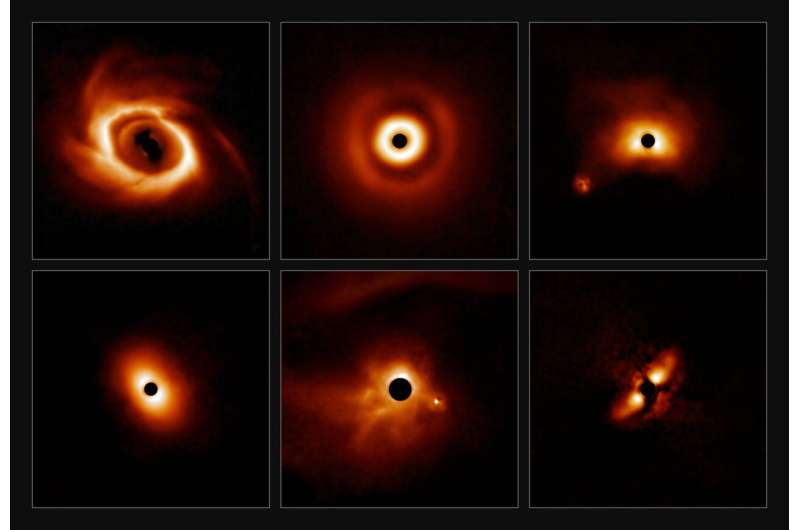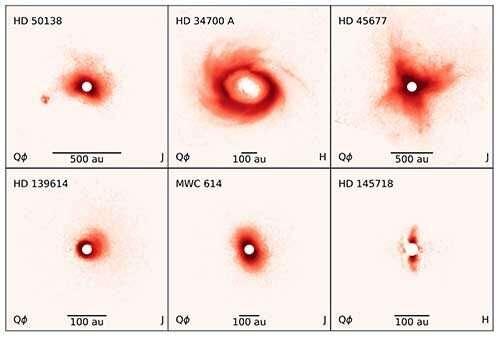Astronomers image dusty disks, uncover companions to distant stars

This mosaic of dusty, swirling disks shows a sample of images captured from the International Gemini Observatory, a Program of NSF's NOIRLab, as part of an unprecedented survey of 44 young massive stars. An international team used Gemini South in Chile to investigate planet formation and uncovered a potential young Jupiter-mass planet, and confirmed the existence of two brown dwarfs. The images will be presented in sessions today at the 240th American Astronomical Society meeting.
This striking image, taken by astronomers using the Gemini South telescope in Chile, is part of a large survey of 44 young, massive stars by the Gemini Planet Imager (GPI) instrument, which imaged their dusty planet-forming disks—likely to become new solar systems—in near-infrared light. The survey found that the disks circling stars up to three times the mass of the Sun tend to have rings, whereas disks around stars that are more massive than three solar masses do not. This suggests that the more massive stars may form planets slightly differently.
Planets form in disks of gas and dust that encircle young stars just a few million years old and GPI is one of a few instruments in the world capable of resolving these disks. Previous observations have indicated that rings, made of large and small dust grains as well as gas, are often seen in these disks. Exactly what creates these rings is uncertain, but they have been attributed to newborn planets interacting with the disk.
Astronomers conducting a survey called Gemini-LIGHTS (Gemini-Large Imaging with GPI Herbig/T-Tauri Survey) have sought to try and answer some of these questions by producing high-resolution images of the disks around a sample of 44 stars.

"We want to answer the fundamental question of how planets form," said Evan Rich, who is a postdoc at the University of Michigan and the lead author of a new paper describing the results in The Astronomical Journal. In particular, he says the Gemini-LIGHTS survey, "concentrates on stars that are more massive than the Sun to investigate the influence that a parent star's mass might have on the planet-formation process."
Gemini South captured the images of the disks in near-infrared and polarized light. It found disks around 80% of the 44 targeted stars, and also found one new candidate planet (around V1295 Aquilae) and three brown dwarfs. Two of the brown dwarfs (around the stars (V921 Sco and HD 158643)) had already been identified as candidates by earlier observations and which have now been confirmed through these observations; the third brown dwarf, around the star HD 101412, is a new candidate.
The survey's key finding, however, is that the disks appear to behave differently depending upon the mass of the star they are circling. "Systems with small dust-grain rings are only found around stars with masses less than three times the mass of the Sun," said Rich. "This is important because forming planets are thought to create the ringed structure, and our findings suggest that the planet formation process might be different for stars larger than three times the mass of the Sun."
This information will be presented in a press conference and oral presentation today at the 240th American Astronomical Society Meeting.
This research was presented in a paper to appear in The Astronomical Journal.
More information: Gemini-LIGHTS: Herbig Ae/Be and massive T-Tauri protoplanetary disks imaged with Gemini Planet Imager, The Astronomical Journal (2022). DOI: 10.48550/arXiv.2206.05815
Journal information: Astronomical Journal
Provided by NOIRLab




















